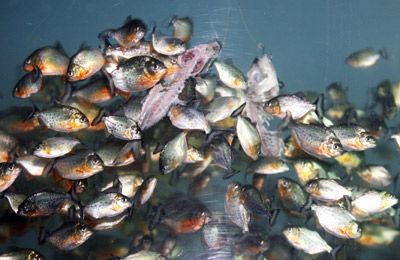Key Takeaways
- Fish rise and sink in water primarily using a swim bladder, which they inflate or deflate with oxygen to adjust their buoyancy.
- The swim bladder's volume changes allow the fish to displace different amounts of water, balancing the forces of buoyancy and gravity.
- Some fish, like sharks and rays, lack a swim bladder and instead use their fins and forward motion to create lift and adjust their depth.
Fish are a bit like birds or flying insects: They have built-in mechanisms that allow them to move up and down and side to side in their environment. But the methods that let fish do this are closer to the principles behind manmade flying machines than to natural flying methods. Most fish rise and sink in the water the same way a helium-filled balloon or a hot air balloon rises and sinks in the air.
To see how this works, you need to understand the various forces at work in the air and underwater. While these environments seem very different to us, water and air are actually very similar. Both are fluids, substances with mass but no shape. On Earth, an object immersed in a fluid (such as a fish or a person) experiences two major forces:
Advertisement
- The downward pull of gravity
- The upward push of buoyancy
Buoyancy is caused by a difference in fluid pressure at different levels in the fluid. Particles at the lower levels are pushed down by the weight of all the particles above them. The particles at the upper levels have less weight above them. Consequently, there is always greater pressure below an object than above it, so the fluid constantly pushes the object upward.
The force of buoyancy on an object is equal to the weight of the fluid displaced by that object. For example, if you submerge an empty gallon milk jug in a bathtub, it displaces a gallon of water. The water in the bathtub then pushes up on the jug with a little more than 8 pounds of force, the weight of a gallon of water. An object with greater volume is pushed up with greater force because it displaces more fluid. Of course, if the object is denser (and therefore heavier) than water, it doesn't matter how much water it displaces -- it will still sink.
To ascend, a fish must reduce its overall density by increasing its volume without significantly increasing its mass. Most fish do this with something called a swim bladder. A swim bladder is just an expandable sac, like a human lung. To reduce its overall density, a fish fills the bladder with oxygen collected from the surrounding water via the gills. When the bladder is filled with this oxygen gas, the fish has a greater volume, but its weight is not greatly increased. When the bladder is expanded, it displaces more water and so experiences a greater force of buoyancy. When the bladder is completely inflated, the fish has maximum volume and is pushed to the surface. When the bladder is completely deflated, the fish has minimum volume and sinks to the ocean floor. To stay at a particular level, a fish fills its bladder to the point at which it displaces a volume of water that weighs what the fish weighs. In this case, the forces of buoyancy and gravity cancel each other out, and the fish stays at that level.
Most fish rise and sink using this method, but not all do. Some species don't need a swim bladder because they spend all their life skimming along the ocean floor. Other fish, such as rays and sharks, ascend and descend by propelling themselves forward. Just as in an airplane, the movement of fluid under the fins creates lift, which pushes the fish upward.
Advertisement


